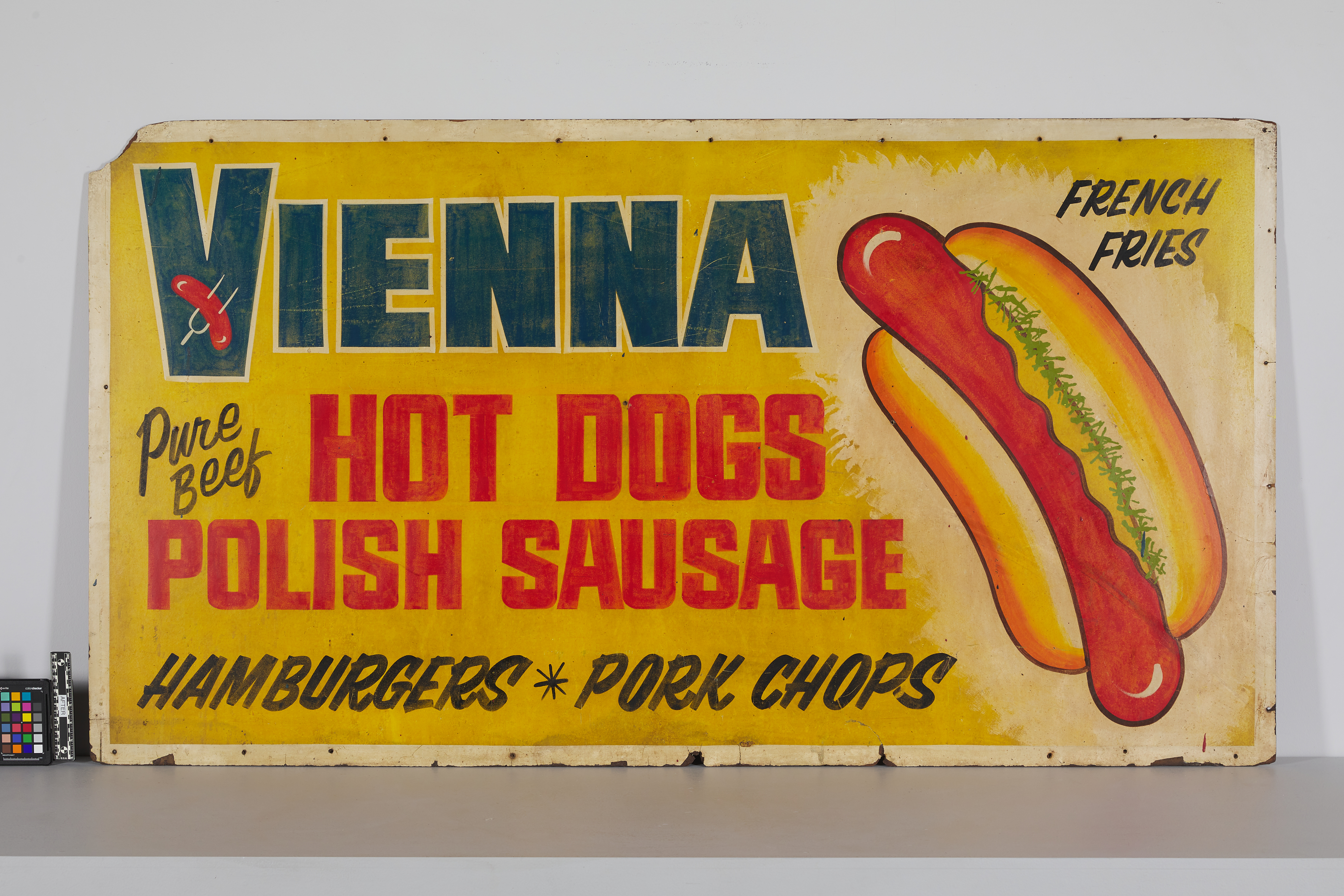
The “Vienna Beef” Sign – plea for support!
The Maxwell Street Foundation (MSF) hosted a webinar on Zoom led by The Conservation Center on 10/19/2020, where the Center’s conservators virtually walked us through their conservation process recently completed for the “Vienna Beef” sign from the MSF’s collection of Maxwell Street artifacts.
Maria Ochalek, the Director of Client Services at the Center, welcomed the group and spoke about The Conservation Center as the largest private art conservation lab in the USA. It’s located in Chicago’s West Town neighborhood in a former gold storage facility, with the adaptive reuse of the building designed by architect Jeanne Gang.
Lori Grove of the MSF spoke about our colorful “Vienna Beef” sign, which is about 3’ x 5 ½’ on paper & masonite. It is one of the few pieces in the MSF collection where there is no provenance. When the market was moved from its historic location on Maxwell Street in 1994, the MSF was collecting a variety of artifacts with no dedicated central collection storage, and sometimes we received items from third parties. This was an item that we recorded as coming into our collection in 1996, two years after the move in 1994, and we do not know who donated it or where the piece was displayed at the Market. The sign could be c. 1950s-80s. Lori was curious to know whether it might be the work of commercial artist Gus Korn, who worked for Vienna Beef doing advertising work. The Vienna Beef factory was in the Maxwell Street neighborhood starting in 1893 for many decades until they moved to their Damen location, and provided local street stands and restaurants that sold Vienna Beef products in the Market area with Vienna Beef signs.
Josh, the Head of Object Conservation, explained the condition of the piece with photos, showing the damage in terms of tears to the masonite. He treated these areas by injecting an acrylic resin in a solvent near the edges where there was damage, which wicked into the pores to shore up and stop further damage to these areas. He used clamps to keep down any swelling. In certain areas, he put a caul, or patch of Kozo paper, which is a special paper used in conservation, on the back of the piece where the board was torn all the way through.
Bozena, the Head of Paper Conservation, had the actual sign behind her, and spoke about doing many initial tests to determine what the surfaces showed in terms of the composition of the stains. She found that many of the stains were fat or grease stains, so she feels the piece may have been inside, near cooking areas. She felt that the colors were water soluble and the lines were not sharp, so she doesn’t think it was screen printed or fully screen printed, but she is not sure. Bozena painstakingly cleaned the piece with warm water, and used an alcohol swab to kill areas with mold. Bozena also did some in-painting with watercolors to make the surface more even.
Maria emphasized the distinction between restoration and conservation — The Conservation Center only does conservation. This means everything they do is reversible, so if there are advancements in the future in conservation, their work can be undone. In other words, with a piece of furniture, they would never strip the old finish off and restore — they would only conserve what was there with reversible methods.
Lori talked about the MSF’s plans for the sign. The Foundation intends to program the conserved sign with a detachable mounting system that will make it safely lendable to organizations for display. The MSF has loaned artifacts or created their own small exhibits for display of Maxwell Street Market history to places like the Museum of Science and Industry, the University of Illinois at Chicago, Chicago History Museum, Spertus Institute, Harold Washington Library, Vienna Beef, and St. Ignatius College Prep to name a few.
The Foundation seeks supporters who will help the Foundation pay for the Vienna Beef sign’s conservation and mounting system!
The conservation of the sign was $1,580. Maria then showed the custom mount making proposal on screen that The Conservation Center could make while the sign is still in their possession, which is proposed to cost $935. The piece has adjustable brackets that use gravity to conservation standards so they do not harm the sign. The brackets attach to a structure that goes behind the sign with two holes where hardware would be used to attach the back mount to the wall. Included in this, The Conservation Center would create a container for the piece and for the mount separately out of soft archival materials and cardboard. This would be sufficient for careful local transport, although The Conservation Center still recommends contracting with an art handler for any transport. However, if the MSF was going to be shipping the piece over any distance, they could create a box & crate for the sign and its mount for this, and this would be an additional quote/fee. This may be a future fundraising goal.
The MSF urges anyone interested in donating to offset the expense of the conservation and to help with the proposed mount for future display of this iconic piece planned for a variety of venues in the coming years. Please go to our website to use the “Support us” tab to donate through PayPal, or send a check to our post office address below. The MSF is a 501 (c) (3) organization and your donation will be tax deductible and each donor will receive an acknowledgement letters at the end of the tax year in which the donation was received.
Please help support our MSF initiatives to preserve Maxwell Street History. In advance, we thank you!
http://maxwellstreetfoundation.org/support-us/
Maxwell Street Foundation
P.O. Box 4307
Chicago, IL, 60680-4307
